
Military, WW2
Snipers and Sniper Rifles of WW2
The stories of World War II snipers are some of the most unbelievable stories you’ll ever hear. These men and women accomplished unfathomable feats fighting for their countries, forcing a shuddering fear into the bones of the enemy.
In this article, we’ll be learning about the most noteworthy snipers of the Second World War, their stories and accomplishments, and the sniper rifles they used.
Vladimir Gavrilovitsj Salbiev (USSR) – 601 Confirmed Kills
Statistically, Salbiev is the sniper with the highest kill count during the Second World War. He served as a member of the 71st Guards Rifle Division, where he quickly became a prominent sharpshooter.
His actions came to public and military attention during the Battle of Stalingrad, when he reportedly killed more than 150 German soldiers.
Because of the sheer number of kills he had made and the mental effect that had on the Germans, Vladimir (among other snipers) was treated somewhat as a god.
Stories were written about him in the media, undoubtedly to motivate the troops, but also to convince the civilians that the war wasn’t yet lost. Like many others, Vladimir became a national symbol of heroism.
He also took part in Ukraine’s liberation, where he served as a commander of a sniper unit. At one point, he was wounded, but he returned to battle as soon as he had recovered. Over the course of the war, Salbiev was wounded three times.
Aside from being a top marksman himself, he was also an instructor and passed his knowledge on to many Soviet soldiers. For his exemplary record, 21 awards were bestowed upon him.
Vasily Shalvovich Kvachantiradze (USSR)– 534 Confirmed Kills
 Georgian born sniper Vasilij Kvachantiradze fought for Russia during WW2. He had over 530 confirmed kills.
Georgian born sniper Vasilij Kvachantiradze fought for Russia during WW2. He had over 530 confirmed kills.
Vasily didn’t get involved in the war until 1941, when he was deployed, as a sniper, with the 650th Rifle Regiment. During the Battle of Stalingrad alone, Kvachantirazde killed 60 enemy combatants. By June of 1944, almost two years after the beginning of the Battle of Stalingrad, Vasily had 221 confirmed kills.
From that record, up until December of the same year, he killed at least 215 enemy combatants. By the end of the war, he would have 534 confirmed kills, making him the most successful sniper of the Kvachantiradze-Okhlopkov-Smolensky trio.He was later awarded the ‘Hero of the Soviet Union’ title.
Simo Häyhä, the White Death (Finland) – 500+ Confirmed Kills
 Simo Hayha was called The White Death by Russian troops. And with good reason. He killed over 500 Russian soldiers.
Simo Hayha was called The White Death by Russian troops. And with good reason. He killed over 500 Russian soldiers.
The White Death, as they called him, was a Finnish military sniper, and he’s widely regarded as the greatest sniper of all time. Simo grew up in Finland, near the border with Russia, where he spent a lot of time hunting long before he joined the military. While still a civilian, Häyhä was known for his amazing marksmanship and was regularly winning sharpshooting competitions. He volunteered as a member of the Civil Guard when he was just seventeen and later joined the Army through compulsory service. It’s difficult to believe, but Simo didn’t get sniper training until 1938, just a year before the Winter War.
For clarification, the Winter War was a short war that started three months after the Germans invaded Poland. To make a long story short, the USSR invaded Finland, but were driven out after three months and suffered massive losses. During the Winter War, Häyhä quickly came to national and international attention because of the, quite frankly, absurd number of kills he made as a sniper. On average, he was killing five Soviet soldiers a day, and he killed around 500 men during the three-month war.
The temperatures in Finland were astonishingly cold, reaching -40°C at times. Häyhä adapted to the environment and wore an entirely white camouflage suit, making him invisible to Soviet troops. The Soviets, on the other hand, didn’t have winter camouflage and they were easily spotted against the white background.
Because of this, the Red Army called him “The White Death”, as all his victims would see before dying was white all around them, without ever seeing the sniper himself. The lethal sniper used a SAKO M/28-30 rifle, which is very similar to a Mosin-Nagant rifle, and a Suomi KP/-31 submachine gun when fighting in close quarters. Impressively, he never used telescopic sights so he could remain a smaller target when taking aim, not to mention that telescopic sights at the time would fog up in the extreme cold.
He would camouflage himself by arriving at the location before dawn, mounding up snow to hide himself, and staying there until sunset. In March of 1940, Häyhä was almost killed by an explosive round which removed his left cheek, and most of his upper and lower jaw. It took 26 surgeries for Häyhä to recover, but his face remained disfigured.
Simo Häyhä wrote a memoir, which was discovered in 2017 (fifteen years after his death), in which he estimates his own kill number to be around 500. The Finnish Army credits him with 259 kills, while his own division commander confirms the 500-kill estimation. Because of his service and his incredible results in the field, Simo Häyhä was awarded with several honours. He died in 2002, at 96 years of age. About the soldiers he killed, he said “I did what I was told to do, as well as I could. There would be no Finland unless everyone else had done the same.”
Ivan Mikhailovich Sidorenko (USSR) – 500+ Confirmed Kills
 The face of death. Soviet Union sniper Ivan Sidorenko. His kill tally was over 500 men.
The face of death. Soviet Union sniper Ivan Sidorenko. His kill tally was over 500 men.
Out of all the snipers mentioned in this article, Lieutenant Sidorenko might be the most impressive one as he’s mostly a self-taught sniper. Even when he was assigned to teach other soldiers to snipe, he was teaching them his own methods.
His methods were clinical, and because of that, the Red Army preferred to utilise him as an instructor, as opposed to risking his death in battle. Despite his on and off combat engagement, he still acquired more than 500 confirmed kills and he personally trained more than 250 Russian snipers. Ivan Mikhailovich Sidorenko is the most successful Red Army sniper, given that he ended his career with the rank of a Major.
Fyodor Okhlopkov (USSR) – 429 Confirmed Kills
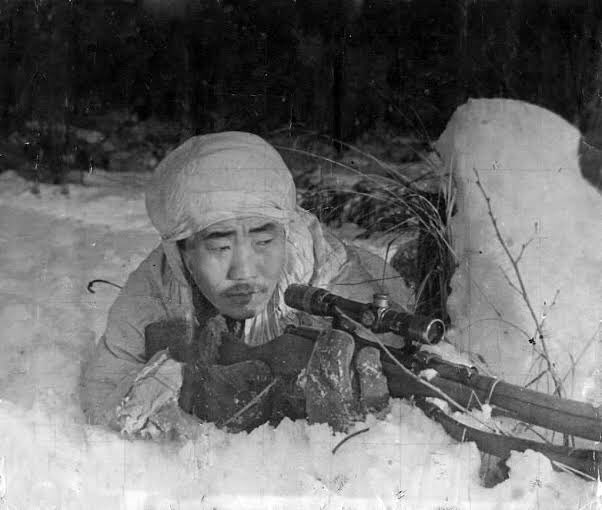 Fyodor Okhlopkov registered 429 kills during WW2. He was wounded 12 times.
Fyodor Okhlopkov registered 429 kills during WW2. He was wounded 12 times.
One of the most well-known Soviet snipers, famous for his work alongside Kvachantiradze and Smolensky, Okhlopov registered 429 kills during the Second World War. Although he was initially posted as a machine gun operator in 1941, he was appointed to the 234th Infantry Regiment as a sniper less than a year later. He was quickly injured along with 80% of his division, but when he returned he was more lethal than ever.
It was well-known that he only needed a single shot to take his target down, which he also proved by duelling with other snipers – he would wait for them to shoot first. After giving up their position, the sniper would usually get taken down with a single round. Altogether, Okhlopkov was wounded twelve times during his service, which forced him to retire from military service. By the end of his service, he had killed 456 people, 429 of which he killed with his sniper rifle. He was awarded with several honours, including the title ‘Hero of the Soviet Union’ and the Order of Lenin.
Fedir Dyachenko (USSR) – 425 Confirmed Kills
Ukrainian by birth, Dyachenko was one of the most successful snipers of the Second World War. Very little is known about his life – he was born in modern-day Ukraine, he was drafted in 1941, and he remained in service until 1962, retiring with the rank of Major. During his service, he killed 425 enemy combatants. A great number of those combatants were enemy officers, on whom he concentrated greatly.
Matthäus Hetzenauer (Germany) – 345 Confirmed Kills
During his two years of service, this Austrian sniper registered 345 kills, making him the most successful Nazi sniper of the Second World War. He also recorded possibly the longest kill of the Second World War at 1100 metres. For a long time, Hetzenauer operated under heavy artillery fire, disregarding his own safety to take another shot. After the war had ended, he was captured by Soviet troops and imprisoned for five years.
Lyudmila Mikhailovna Pavlichenko (USSR) – 309 Kills (Number Contested)
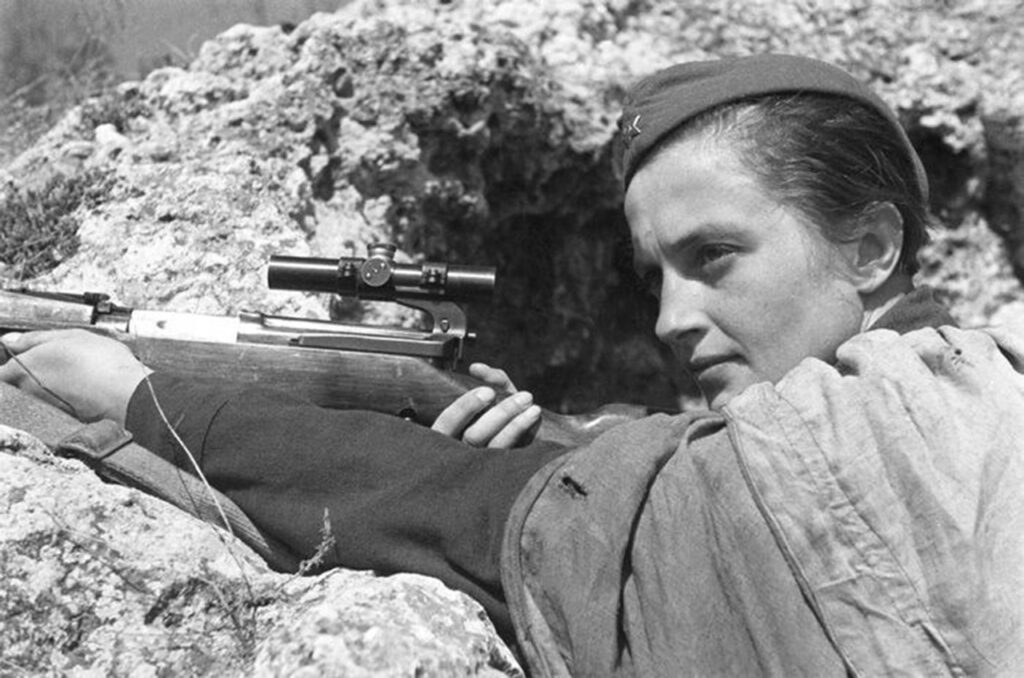 Lyudmila Pavlichenko photographed in 1942. She kept a diary and claimed she killed over 300 men
Lyudmila Pavlichenko photographed in 1942. She kept a diary and claimed she killed over 300 men
Having to stop her studies at the Kyiv University to fight Nazi Germany, Pavlichenko wanted to serve in an infantry unit. Red Army officials initially tried to place her in a hospital to be a nurse, but she refused that offer, as she was already trained to be a sniper in civilian sniper courses.
There were about 2000 female snipers in the Red Army, and she would quickly become the most famous. She got a Mosin-Nagant rifle by chance, picking it up off a fallen combatant, and quickly started taking down enemy combatants, seemingly with little effort.
During the four years of active war service, it’s assumed she killed 309 enemy combatants. This number is contested because her own claims and stories changed every time she was interviewed, and it’s possible that Soviet media built those numbers up for propaganda. The real number is probably still high, possibly quite close to the official 309 number, but there’s still no evidence to prove or disprove the claim.
Roza Georgiyevna Shanina (USSR) – 59 Confirmed Kills
The story of Roza Shanina is a touching one. At just seventeen years of age, Roza’s brother Mikhail was killed in the Battle of Leningrad, and motivated by his death, Roza decided to volunteer in the army, despite being passed over in the recent draft.
She was accepted into a military training program and was later sent to the Central Women’s Sniper Training School. She graduated with honours and was one of the best in her class, later refusing to stay as an instructor, preferring to fight on the front lines. She immediately got her own platoon within the 184th Rifle Division and quickly killed her first enemy. Shanina’s diaries were later discovered, in which she wrote about how difficult it was for her to take a life for the first time. A few months later, she was completely unemotional about it, as she found her purpose in life was fighting.
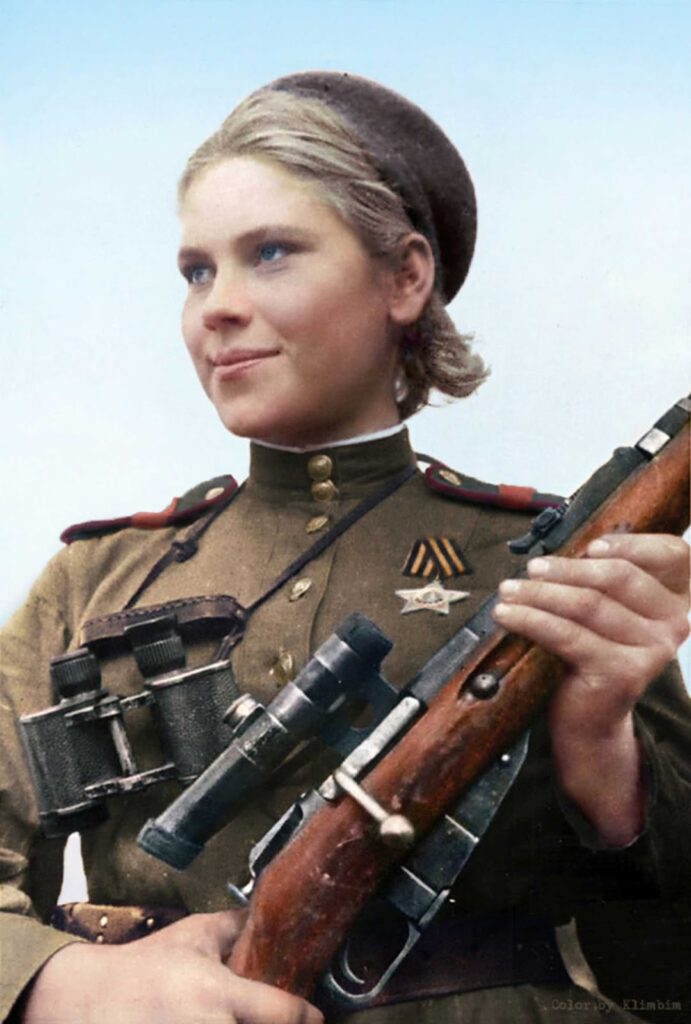 Roza Shanina holding an Mosin–Nagant with scope in 1944 (Colourised Photo)
Roza Shanina holding an Mosin–Nagant with scope in 1944 (Colourised Photo)
As she got more reported kills, a myth started to build around her and a lot of Soviet propaganda at the time used her image to motivate the troops. On one occasion, Roza went to the front lines of the Vitebsk region despite being ordered not to (even after submitting an official request). She was subsequently sanctioned, but no court martial action was taken.
Similar to Simo Häyhä, Roza Shanina improvised camouflage methods and was a champion of counter-sniper tactics. She was killed during the East Prussian Offensive, just a few months before the war had ended – a shell fragment ripped her chest open and disembowelled her. During her service, she established a confirmed tally of 59 kills, which can’t be compared to some of the incredible numbers of other Soviet snipers, but her sheer courage, rushing to the front lines, and ingenuity under pressure inspire Russians even to this day.
The Most Important Sniper Rifles of WW2
Four of the most common sniper rifles in WW2 are the Soviet Mosin-Nagant, the British Lee-Enfield, the German Karabiner 98k, and the American Springfield 1903 sniper rifle
The Mosin-Nagant is perhaps the most iconic sniper rifle of the Second World War, given that it was widely distributed among the Red Army and all Soviet snipers used it. Altogether, around 37 million were made!
These rifles use 7.62x54mm rounds and have an effective firing range of more than 800 metres (with a scope). It was a very effective weapon in combat and the men and women who used it had nothing but praise for it.
 A Soviet Mosin–Nagant model 1891/30 rifle with PU 3.5×21 sniper scope.
A Soviet Mosin–Nagant model 1891/30 rifle with PU 3.5×21 sniper scope.
The Lee-Enfield is a .303 (7.7x56mm) rifle with an effective range of around 500 metres. During the Second World War, It was the No.4 Lee Enfield that was accepted into the service of the British Army.
In comparison to the SMLE of WW1 the No.4 was heavier because of a heavier barrel, but it served the British troops well thanks to its robustness and reliability.
Bolt Action
The Karabiner 98k, also known as the Mauser 98k, was a 7.92x57mm bolt-action rifle distributed among the Wehrmacht during the Second World War. It’s perhaps the most technologically advanced rifle out of the big four, with an effective firing range of more than a kilometre with a scope.
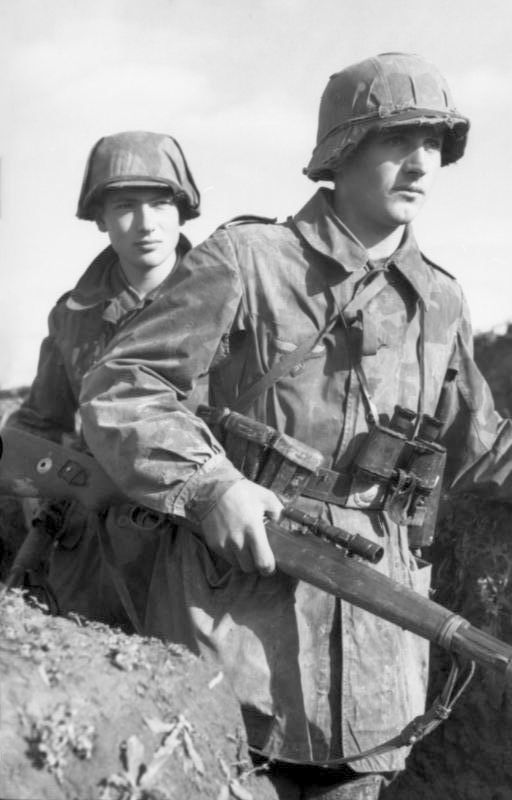 A Soldier of the Luftwaffe Field Division with his K98K and mounted ZF41 scope on the Eastern Front, 1942
A Soldier of the Luftwaffe Field Division with his K98K and mounted ZF41 scope on the Eastern Front, 1942
Its open firing range was almost five kilometres, but there’s no record of anyone ever hitting a target at any distance even close to that. It was paired with a telescopic sight that actually added compensation for bullet drop at a distance. There’s an argument to be made that the German Army was impaired by the bolt-action system used in this rifle, as it had a lower rate of fire than weapons from the Allies.
Finally, we have the M1903 Springfield, a magazine-fed, .30-03 (7.62x65mm) calibre sniper rifle with a limited effective range of only 460 metres. These sniper rifles were, unfortunately, inadequate. The reason for this wasn’t the rifle itself, but the scopes, which weren’t waterproof, and they would become foggy or fill with water, not to mention that they didn’t magnify well.
Why Did the USSR Have So Many Good Snipers?
This may come as a shock, but the Soviets were the only ones who invested in their snipers. Although Germany pioneered the field at the beginning of the century, Soviets were the only ones with advanced sniper schools. And not only did they have sniper schools – they had thousands upon thousands of soldiers graduating from them. More than 400,000 soldiers received sniper training during the Second World War.
It’s a common misconception that the Red Army was underdeveloped and backwards in many ways. In reality, their military doctrine and methods of warfare were just as advanced as everyone else’s, while they were the leaders in the field of sniping. There are also a few other factors to account for.
Firstly, unlike all the other participants in the Second World War, a lot of people in the USSR lived an isolated life. It was, at the time, the biggest country in the world and millions of Soviets relied on hunting to get meat, not to mention that many dangerous animals (including bears and tigers) lived in what is modern-day Russia. Secondly, in 1941, almost 200 million people lived in the Soviet Union, meaning that there was a massive pool of talent for the military to pick at. Unlike all other countries, the Red Army wasn’t particularly interested in gender – both men and women could enlist and attend sniper school if deemed fit.
Finally, the story comes back to Simo Häyhä and other Finnish snipers who absolutely devastated Soviet forces in the Winter War. Keep in mind Russia wasn’t at war with Germany from the beginning of Germany’s invasion of Poland – they only joined later. Because of this combination of factors, the Soviets started actively training their snipers and invested a lot of time and money in those units, making them the best in the world.
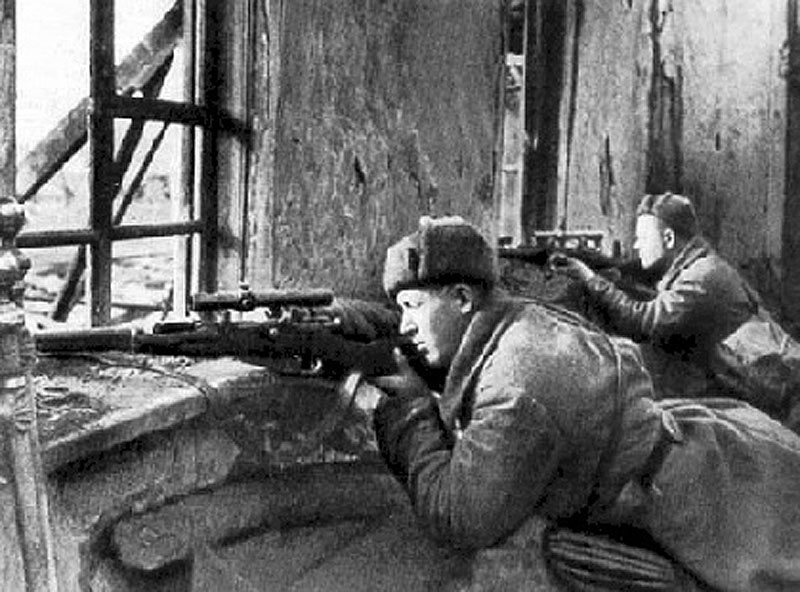 Over 400,000 Russian soldiers had sniper training during the Second World War.
Over 400,000 Russian soldiers had sniper training during the Second World War.
The Red Army witnessed the power of snipers first-hand and decided to teach their soldiers how to kill the enemy at a distance. The power of a sniper doesn’t only come from the accuracy or the tactical advantage it brings, but also from the fear it instils in the enemy. Knowing that you could die any second with no prior warning and that nowhere is safe will drive fear into any soldier. They understood this, and this is what made the Soviets the best snipers in the world.
News
The Hanging Temple: China’s 1,500-Year-Old Cliffside Marvel of Faith and Engineering
The Hanging Temple: China’s 1,500-Year-Old Cliffside Marvel of Faith and Engineering Perched precariously on the cliffs of Mount Heng in Shanxi Province, China, the Hanging Temple, also known as Xuankong Temple, Hengshan Hanging Temple, or Hanging Monastery, is an architectural…
The Willendorf Venus: A 30,000-Year-Old Masterpiece Reveals Astonishing Secrets
The Willendorf Venus: A 30,000-Year-Old Masterpiece Reveals Astonishing Secrets The “Willendorf Venus” stands as one of the most revered archaeological treasures from the Upper Paleolithic era. Discovered in 1908 by scientist Johann Veran near Willendorf, Austria, this small yet profound…
Unveiling the Maya: Hallucinogens and Rituals Beneath the Yucatán Ball Courts
Unveiling the Maya: Hallucinogens and Rituals Beneath the Yucatán Ball Courts New archaeological research has uncovered intriguing insights into the ritual practices of the ancient Maya civilization. The focus of this study is a ceremonial offering found beneath the sediment…
Uncovering the Oldest Agricultural Machine: The Threshing Sledge’s Neolithic Origins
Uncovering the Oldest Agricultural Machine: The Threshing Sledge’s Neolithic Origins The history of agricultural innovation is a fascinating journey that spans thousands of years, and one of the earliest known agricultural machines is the threshing sledge. Recently, a groundbreaking study…
Nara’s Ancient Sword: A 1,600-Year-Old Protector Against Evil Spirits
Nara’s Ancient Sword: A 1,600-Year-Old Protector Against Evil Spirits In a remarkable discovery that has captured the attention of archaeologists and historians alike, a 7.5-foot-long iron sword was unearthed from a 1,600-year-old burial mound in Nara, Japan. This oversized weapon,…
The Inflatable Plane, Dropped Behind the Lines for Downed Pilots
Experimental The Inflatable Plane, Dropped Behind the Lines for Downed Pilots The Inflatoplane from Goodyear was an unconventional aircraft developed by the Goodyear Aircraft Company, a branch of the renowned Goodyear Tire and Rubber Company, also famed for the Goodyear…
End of content
No more pages to load











